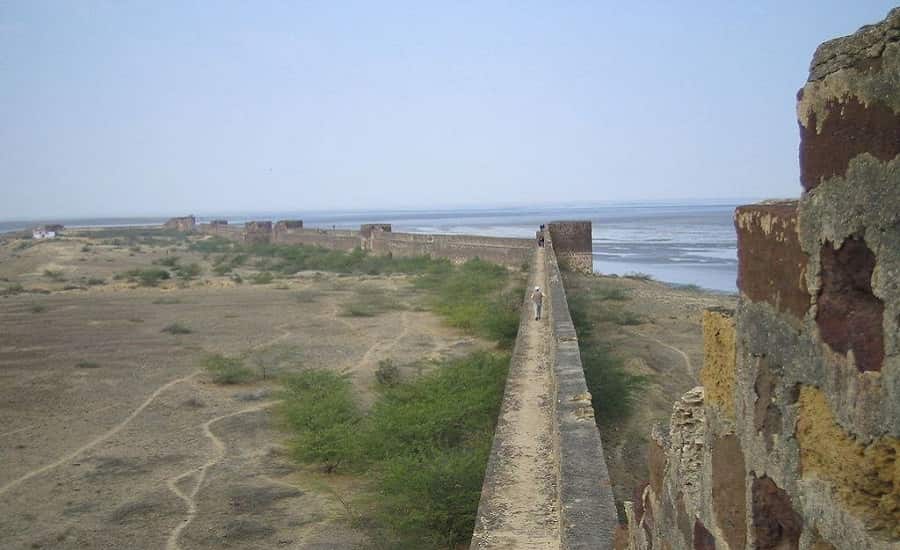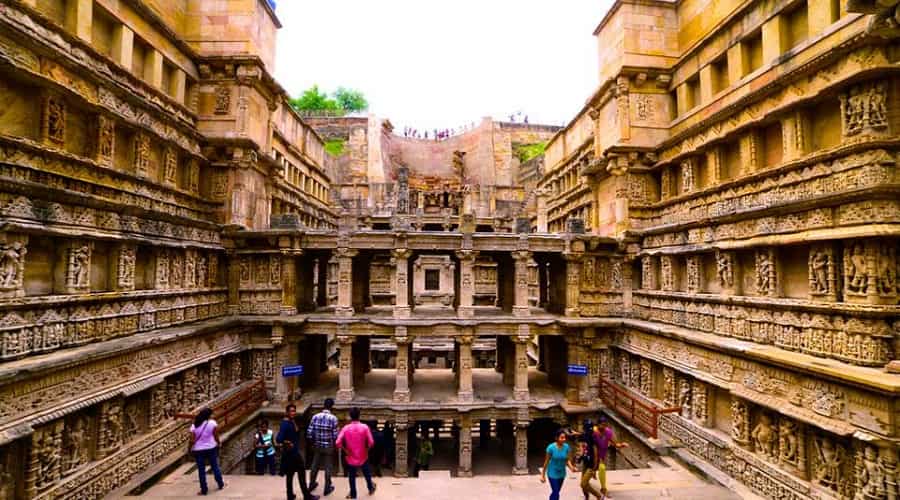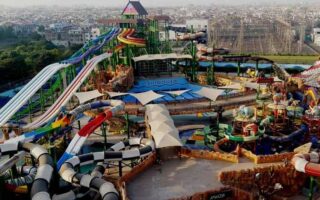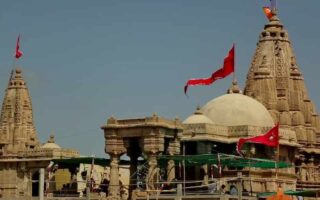- Location: Western India, In India Pakistan Border.
- Founded by: Rao Lakha
- Best time to visit: October to May
- Local Transport: Non-metered auto rickshaws only available at Narayan Sarovar.
- Places to see: Tomb of Gosh Mohammad, Gurudwara, temples.
- Souvenirs: Nostalgia
Lakhpat, the sea fort is astounding with its situation right near the mouth of the Creek of Kori. History has it that the waters of the River Sindhu used to empty into Lakhpat and Gunthli. Lakhpat used to cultivate rice and generate a rich income with its maritime activities. In 1819 AD, there was an earthquake. Sindhu changed its course of flow and today Lakhpat is left with very little population. Due to the earthquake, the course of River Sindhu changed and shifted 50 miles west. Thus the unbelievably wealthy Lakhpat lying on the Sind and Kutch border very unlike its name (one-lakh rupees) turned into a sandy desert from a rich fertile land.
Since it is located near the Pakistan border, there are two families living there – Hindu and Muslim. This city once upon a time was an important port for the Muslim pilgrims going to Haj. They used to go to Medina and Mecca each year from here. Even the Sikh Guru, Guru Nanak stayed in Lakhpat before he went to visit Mecca and Madina. Also it is said that during the Muslim invasion the Khudabadi Sonara community who had not converted to Islam under the rule of Ghazni went to Vegh Kot and Lakhpat in 1028 AD. They settled here peacefully under the Hindu rulers.

Lakhpat – Down the Ages
Lakhpat, the earthquake city, is a fortified town with high walls, many gates and hard stone bastions. Today it is a ghost town with hardly 150 people living here. The city has two cell towers in the middle of the ruins. There is a salt factory and many army bases. Today Lakhpat, the ghost town, stands unwanted, uninhabited and facing the brunt of the divide between Kutch and Sind. neglected by the River Sindhu.
Lakhpat – A Rendezvous
Lakhpat is the last town situated at the westernmost part of India in the border area between India and Pakistan. It lies at the meeting place of the Kori creek and the Rann of Kutch. Deriving its name from the daily income it used to get (one lakh Kori), it was founded by Rao Lakha. The city in spite of being in a neglected state still has its beauty with the tomb, mosque and finely carved edifices remaining.
Lakhpat – Travel kitty
If you want parched throats, ruined destruction, deserted lands and scanty surroundings, then come to Lakhpat, the desert land. Once a thriving city with richness at its feet, Lakhpat today stands though with pride, yet with a lot of history to tell. Lakhpat is today in ruins wondering what went wrong with the relation it had with River Sindhu. A tourist coming here can take the ethos of the city as travel kitty and never ever forget to think of this city whenever the thought of calamity and disaster creeps in.
Places to Visit in Lakhpat
With an aura of a dignified bride, and an air of a soldier protecting the country, Lakhpat today stands tall with its quite, intense ruins and is a symbol of never say die attitude. Once a thriving city and today a ruin, this city has a lot more to show than to tell. What is left today is nothing to relate but everything to feel, what was there is the following:
Tomb
The Tomb of Gosh Mohammad
Gosh Mohammad was a famous saint who was respected by both Hindus and the Muslims. An elegant tomb in his memory has been constructed after his death in 1855 AD. This octagonal structure with a dome is built using hard stone and has four entrances. There are columns and arches with decorative work on each side, niches that are intricately carved with floral motifs and the tree of life. The walls inside are exquisitely decorated with verses written in calligraphy from the Holy Book Koran.
Temples And Religious Places
Gurdwara
This is the sacred place of the Sikhs. This place is related to the Sikh Guru Nanak. It is believed that Guru Nanak went to Haj and Mecca from Lakhpat. This Gurudwara has been constructed in memory of this event. Sikhs visit this Gurudwara throughout the year.
Besides this, there is a mosque and a structure for keeping the Muslim religious float “Tajia”.
Kalyaneshwar Temple
This is situated very near the Koteshwar temple. It is at the edge of the sacred “kund”. This “kund” gets filled up during high tide. The Hindus have a bath here and perform the rituals here.
Koteshwar
This is situated around 52km from the city of Lakhpat. This is a famous pilgrim spot and is at the farthest end of Western India. It lies near the Kori creek. A Hindu normally surely visits the Koteshwar temple and the Narayan Sarovar. According to Hiuen Tsang in 640AD the town Koteshwar had 80 monasteries and 5000 monks. Nothing exists today. Today the town is fortified town with high walls. Inscriptions show that the present structure is also a renovated structure, which was done sometime in the 18th century. This was considered to be done by the merchants Jetha Sivji and Sheth Sundarji. The presiding deity in the temple is Lord Shiva. The temple looks elegant with its white painted high wall, the high dome with saffron flags and images of all the Gods and Goddesses like Hanuman, Ganesh, Parvati, and Shivling.
Adi Narayan, Goverdhan Nath, Dwarkanath, and Lakshmiji are other temples.
Lakes
Narayan Sarovar
This is situated 49 kms from Lakhpat and is one of the five holy Indian lakes. Mansarovar in Tibet, Pushkar in Rajasthan, Pampa in south India, and Bindu Sarovar in Sidhpur
are the other four. It is located just 2 km away from Koteshwar temple. Alexander the Great has mentioned this lake in his chronicles. The temple priest had embankments on the lake constructed on all three sides but not on the east in 1550 AD. He also constructed separate areas for bathing and used stone jails for this. Vagheli Mahakunwarba was the wife of Rao Desalji. She constructed temples like the Laxmi Narayan temple and Trikamrai temple in the 17th century so that Narayan Sarovar would be at the same level as Dwarka.
Thus, Lakhpat, with its intriguing story behind it and the amazing history it has is also the place where we can see the Chinkara and the Nilgai. A caracal or civet is also seen at times. The peacocks adorn the place and the partridges add to the beauty.
As we leave the city, we think, “Sleeping cities don’t have to sleep, they can be alive even in ruins.”


